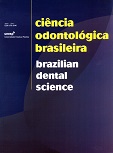Avaliação da influência da ciclagem mecânica na resistência à flexão de cerâmicas
DOI:
https://doi.org/10.14295/bds.2004.v7i2.487Abstract
O objetivo deste trabalho foi avaliar a influência da ciclagem mecânica em dois materiais cerâmicos utilizandoo método biaxial para determinar a resistência à flexão. Vinte corpos-de-prova foram confeccionados com dimensõesde aproximadamente 15mm de diâmetro e 1,2mm de espessura para cada material constituído comdiferentes composições: a) alumina sinterizada e compactada (Procera AllCeram);e.b) zircônia + alumina (In-Ceram Zircônia). Os grupos foram elaborados de acordo com as recomendações dos fabricantes. O total dasamostras, de cada material, foi dividido em dois sub-grupos, um sem e outro com ciclagem mecânica (20000ciclos, carga de 50N e imersão em água destilada a 37ºC) antes do teste de resistência à flexão em uma máquinaInstron. Os dados foram analisados estatisticamente pelo teste de análise de variância de dois fatores e os resultadosindicaram que as médias de resistência à flexão sem e com ciclagem mecânica, da cerâmica Procera AllCeramforam de 647,16±48,04 e 630,39±430,39; e para a cerâmica In-Ceram Zircônia 496,45 ± 35,65 e 457,43 ±53,14, em MPa, respectivamente. Os resultados apresentados indicaram que a ciclagem mecânica não diminuiua resistência à flexão pelo método biaxial, e a cerâmica Procera AllCeram foi estatisticamente significante superiorà resistência à flexão do In-Ceram Zircônia.Downloads
Downloads
Published
How to Cite
Issue
Section
License
Brazilian Dental Science uses the Creative Commons (CC-BY 4.0) license, thus preserving the integrity of articles in an open access environment. The journal allows the author to retain publishing rights without restrictions.
=================




























